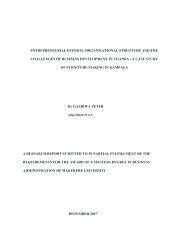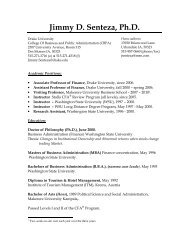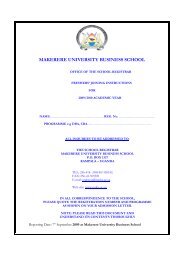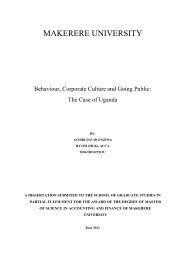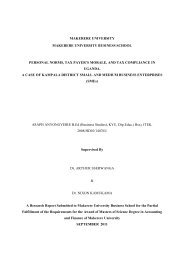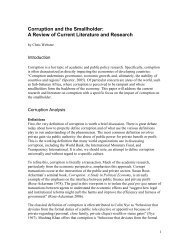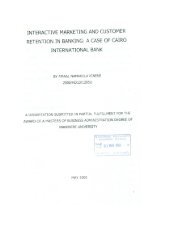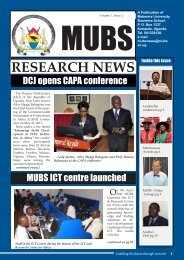13th Annual International Management Conference Proceeding
13th Annual International Management Conference Proceeding
13th Annual International Management Conference Proceeding
You also want an ePaper? Increase the reach of your titles
YUMPU automatically turns print PDFs into web optimized ePapers that Google loves.
In the first half of this century we learned that the community cannot achieve its aims without the help of<br />
government providing essential services and a backdrop of security. In the second half of the century we<br />
learnt that government cannot achieve its aims without the energy and commitment of others – voluntary<br />
organizations, business and, crucially, the wider public … I have always believed that the bonds that<br />
individuals make with each other and their communities are every bit as important as the things<br />
provided for them by the state … Every year thousands of social entrepreneurs achieve extraordinary things<br />
in difficult<br />
circumstances … For all the millions who get involved [in community initiatives and the voluntary sector]<br />
there are millions more who would get involved if they knew how … So I set down a challenge: That we<br />
mark the Millennium with an explosion in “acts of community” that touch people’s lives.<br />
In The Rise of the Social Entrepreneur, Leadbeater (1997) concludes that the UK welfare system is in need<br />
of radical reforms if it is to deal effectively with the social and other demands and he further noted that a<br />
major contribution to this can be made by social innovations – new, creative and imaginative community<br />
initiatives. The need is to innovatively develop new forms of social capital, which, in turn, will help empower<br />
disadvantaged people and encourage them to take greater responsibility for, and control over, their lives.<br />
Social capital is here taken to mean the creation of community-based tangible and intangible assets, which<br />
would otherwise not exist. Tangible examples would include buildings, services and support networks;<br />
intangibles might be trust, identity, reputation and respect for some achievement. This emphasis differs from<br />
the definition adopted by authors such as Fukuyama (1995) who see social capital as “the ability of people<br />
to work together for common purposes in groups and organizations”. Leadbeater’s social entrepreneurs are<br />
all community-based and they are endeavoring to regenerate some locality, which over time can spread from<br />
a neighborhood base to have a national or even an international identity. Nevertheless, many initiatives stay<br />
small and local, mirroring the tendency of many micro and small businesses not to grow into medium-sized<br />
enterprises.<br />
Social entrepreneurship needs some combination of people with visionary ideas, people with leadership skills<br />
and a commitment to make things happen, and people committed to helping others. The process of<br />
entrepreneurship brings together people and ideas, and whilst the “true” entrepreneur does have the requisite<br />
visionary, technical and leadership skills, entrepreneurship can still – and often does – happen when<br />
enterprising or intrapreneurial people are linked up with the visionary idea and opportunity. Arguably, if the<br />
idea or need is strong enough, the appropriate champion will be attracted. Unpublished research by the<br />
Gallup Organisation argues that whilst leadership and entrepreneurship are not synonymous terms, there are<br />
some overlapping characteristics. Charismatic leaders, then, will champion some – but not all –<br />
entrepreneurial ventures. Bendix, (1966), describes charismatic leader-entrepreneurs to be all creative and<br />
innovative, disruptive of the status quo, catalysts for change, and responsive to situations, needs and<br />
opportunities. It can be argued that there are people in the community who are keen to work for their<br />
community, but need leadership and guidance. These people are more likely to be found in abundance than<br />
are true entrepreneurs who choose to work for the community rather than, say, for personal financial gain.<br />
People closest to the community and in the caring professions – such as vicars, doctors, teachers and social<br />
workers – will have opportunities to see and appreciate needs and opportunities, but individually they may<br />
have neither the time, skills nor inclination to do anything about them.<br />
2.3 Relationship between social capital and social entrepreneurship behaviour.<br />
The Theory of Planned Behaviour (TPB; Ajzen, 1988, 1991) proposes a model about how human action is<br />
guided. It predicts the occurrence of a specific behaviour provided that the behaviour is intentional. The<br />
model is depicted in Figure 1 and represents the three variables, which the theory suggests will predict the<br />
intention to perform behaviour. Intentions are the precursors of behaviour.<br />
63



